|

This week
under the northern lights turned out to be poor
for DXing, but we did open one new frontier. We
set up a Beverage antenna pointing at 160 degrees,
which has never before been tried in Lapland. The
new antenna resulted in a motherload of stations
from Iran, many of which had never been heard in
Scandinavia. Aside from DXing, we improved our antennas
and enjoyed hiking in the tundra.
I
and Jim Solatie
left from rainy Helsinki by train on Friday evening
to arrive in equally rainy Lapland early Saturday
morning. We didn't hit any reindeer on the way,
so we had to shop for meat and other groceries the
traditional way... Excluding stops in Sodankylä,
Ivalo and Inari totaling one and a half hours, our
net driving time from Rovaniemi to Aihkiniemi (400
km) was four hours and 40 minutes — good to
know so we wouldn't miss the train a week later
when we returned.
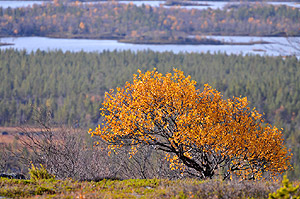
A view from Palovaara
("Fire Mountain") southwest towards
Jääjärvet ("Ice Lakes").
Sure looks fiery this time of the year! |
We consumed the last civilized
meal — prompting Jim to interrupt his fasting
— at Scanburger in Inari, which is probably
the northernmost burger franchise in the world.
Then we were on our own, which meant a busy time
for our microwave oven in Aihkiniemi.
Just once we ventured into the culinary sphere favored
by some of our DXing colleagues. We bought tender
Brazilian filet mignon, which lasted for three days.
No protein deprivation in our diet.
To consume all those calories we worked a lot with
the antennas. We set up two new 1-kilometer (0.7-mile)
long antennas, pointing at 110 and 160 degrees.
The 110° wire was supposed to bring us stations
from Western Australia, Thailand and South Asia,
and had been successfully tried on a temporary basis
a year earlier. Now it was to become permanent.
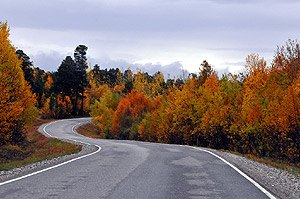
A few more kilometers to Aihkiniemi |
The timing of the DXpedition
was designed to maximize our chances of getting
new Australian AM stations. The result was not a
total disaster, as we did catch a couple of rare
stations from Down Under, but in any case there
were no major openings to Australia. Conditions
were best on September 20, a day after we enjoyed
the best northern lights (aurora borealis) of the
week. Aside from 1152 kHz nothing was heard from
Western Australia, so instead of 110°, Aussie
stations were better heard on the regular 80°
and 60° wires.

The 160° antenna was however a totally novel
experiment. We figured that it should be good for
a few small island nations in the Indian Ocean,
which had eluded our ears for decades. There was
just one problem with the direction. 160° was
not only ideal for Reunion but also for Iran. So
you can guess which one we ended up listening to.
DXing the Islamic Republic

Fall colors on the Ivalo
River |
Iranian stations have often been
treated as notorious indicators of poor propagation:
if nothing else is audible, at least there are Iranians.
Very few AM DXers in Europe have seriously tried
to monitor and log Iranian AM stations. Yet the
country is fairly large and it has an impressive
amount of regional stations which can be heard with
their own programming. They tend to identify promptly
at the hour (30 minutes past the hour UTC), but
many of them are far from easy catches. So, Iranian
stations deserve to be taken more seriously. And
so we did.
Besides, during the solar maximum
it is essential to be able to make a virtue of necessity,
and focus not just on your favorite target but try
to make sense of whatever happens to remain on the
dial.

A toast to all the Iranian
stations! |
Sunday, October 16th was our
first opportunity to take advantage of the 160-degree
wire. At 1530 UTC (19:00 in Iran) conditions were
not yet quite ripe for stations so far West, but
1630 UTC (20:00 in Iran), which is often the last
top-of-the-hour to identify regional Iranian stations,
we had an IRIB galore of an unprecedented scale.
Each evening at the same time,
at 1630 UTC, we identified dozens of Iranian stations,
many with regional programming, and many which we
didn't even know to exist, some unlisted in the
World Radio TV Handbook. To give you an idea of
some exotic catches on this front, have you ever
even heard about Radio Khorasan-e Jonubi from Birjand
on 621 kHz or Radio Khorasan-e Shomali from Bojnourd
on 873 kHz?
Iranians can be heard also in
the early morning hours, but usually not quite as
well. Also for Iran, just like any other direction,
having the right Beverage antenna gives quite a
boost to the signals.
In addition to the Islamic Republic,
most Arab countries happened to be located in the
direction of our new antenna. We did get a few Africans
as well, including Radio Veritas from South Africa
on 576 kHz although conditions were never really
auroral, opening the path straight south.
During AIH17 DXing was pretty much limited to 1500-1800
UTC in the evening and to the early morning hours
until 0400 UTC in the morning. In the afternoons
conditions favored a southern route, without much
of Japan or northern China. Overall conditions during
the morning peak were poor, but we managed to get
a few new stations from both North and South America.
More Antennas Than Ever Before
After our improvements, Aihkiniemi now boast perhaps
the most extensive antenna array ever available
to DXers in Scandinavia. There are a total of 13
Beverage antennas, each roughly 1 kilometer in length,
to choose from.
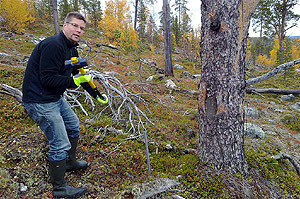
Jim hammering a grounding rod at the end of
the new 160-degree antenna. |
During daytime we had plenty
of time to sleep, repair the antennas or just go
hiking. On the day before our departure we hiked
to Näätämö River almost on the
Norwegian border. The weather was perfect (sunny
and close to +10 degrees Celsius at best), the fall
colors were still visible, but we didn't see anyone
else (reindeer don't count) on the 15-kilometer
hike to and back from a suspension bridge crossing
the river. Luxurious and very private outdoor excitement.
Around our cabin we were this
time not interfered by bears, but instead entertained
by several birds on their way south. Storks, swans
and geese all used our small lake as a resting stop.
There were plenty of lingonberries and even blueberries
all around, a fringe benefit when working in the
forest.
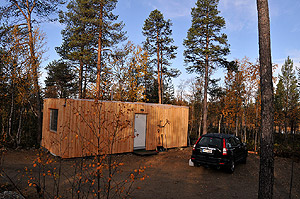
The cabin has a new wooden siding. |
The Aihkiniemi cabin had been
spruced up by previous DXpeditionists turned carpenters
and now has a wooden siding. Next year the roofing
will be remodeled, and then our austere listening
base will begin to resemble a regular cottage.
The first few hours in the cabin
are always a bit chaotic, as we try to assemble
our gear before the evening opening to Asia. This
time setting up our equipment took longer than ever
before, mostly because we again had some new stuff.
For the first time we attempted to use only linear
power sources to minimize interference. Four Perseus
receivers were connected to a power source made
by Jarmo Salmi, producing interference-free 5V outlets.
Already last winter we had equipped
the cabin with four linear power sources for laptop
computers, and now I had bought a bunch of power
supplies for the external hard drives as well. However,
we didn't manage to get rid of all sources of electrical
interference. The quest for perfection continues.
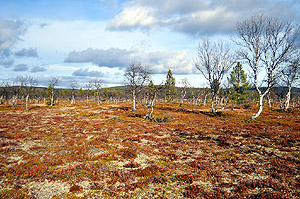
Fall colors on the tundra,
shot during our hiking trip to Näätämö
River. |
Jaguar Eats Perseus
As far as software goes, AIH17
was the first DXpedition when I for the most part
abandoned Perseus software to control the Perseus
hardware, opting instead to use a new software called
Jaguar, which is still being developed, and is only
available as a teamware among the developers. Jaguar
has sharp teeth and it is a very comprehensive tool
for serious AM DXing. Jaguar enables for instance
reliable post-production calibration, which prompted
me to log stations with as precise frequency measurements
as possible. For automated recordings we used Mestor,
which is a simple yet very efficient and reliable
no-hassle recording software.
The following chart lists solar
indices affecting propagation conditions during
the DXpedition. As usual, thanks to Jan Alvestad
for compiling the data.
| Date |
Mea-
sured
solar
flux |
Sunspot
number |
Planetary
A index |
K
indices
(3-hour
intervals) |
Min_max
Solar wind
speed range
(km/s) |
#
of
flares |
ST
AR SDO |
NO
AA |
ST
AR
ap avg |
WDC |
Daily
ap range |
Planetary
(WDC) |
Boulder |
C |
M |
X |
| 2K |
1K |
| 14.9.2012 |
100.5 |
165 |
104 |
44 |
5.5 |
6 |
3-15 |
11111213 |
11112222 |
374-449 |
|
|
|
| 15.9.2012 |
97.5 |
98 |
66 |
53 |
6.1 |
6 |
3-9 |
22211112 |
22222212 |
362-438 |
|
|
|
| 16.9.2012 |
97.3 |
82 |
54 |
77 |
8.5 |
8 |
3-18 |
23121132 |
22122232 |
353-422 |
|
|
|
| 17.9.2012 |
101.5 |
107 |
64 |
51 |
5.6 |
6 |
3-12 |
32111112 |
22112222 |
358-433 |
2 |
|
|
| 18.9.2012 |
104.3 |
107 |
74 |
61 |
10.4 |
10 |
4-18 |
33322311 |
23133222 |
349-412 |
1 |
|
|
| 19.9.2012 |
109.8 |
128 |
91 |
62 |
15.1 |
15 |
4-39 |
23122345 |
13122444 |
324-397 |
2 |
|
|
| 20.9.2012 |
117.4 |
138 |
106 |
68 |
12.8 |
13 |
7-22 |
33433222 |
32322322 |
379-585 |
1 |
|
|
| 21.9.2012 |
116.9 |
149 |
103 |
74 |
7.3 |
7 |
5-12 |
22222321 |
11122311 |
410-530 |
|
|
|
| 22.9.2012 |
124.5 |
185 |
96 |
46 |
6.8 |
7 |
3-12 |
32221112 |
11221111 |
349-471 |
|
|
|
| 23.9.2012 |
133.6 |
198 |
109 |
57 |
0.5 |
0 |
0-2 |
00000000 |
10001210 |
332-371 |
1 |
|
|
| 24.9.2012 |
136.6 |
244 |
162 |
90 |
2.3 |
2 |
0-4 |
00000111 |
00001211 |
300-355 |
3 |
|
|
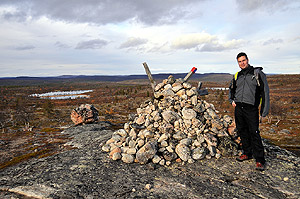
Passing over the top of
Palovaara on the way to Näätämö
River. The mountains in the horizon are in Norway. |
Here's a summary of our DXing
and other activities day by day:
Saturday, September 15, 2012
When we were still connecting
our wires, we got an alert from Bjarne Mjelde in
Kongsfjord about early conditions to Asia. He heard
stations from Hokkaido already after 1300 UTC. Here
only semi-local stations from the Kola Peninsula
were audible, but we did get our first Japanese
signals before 1400 UTC. Around 1630 UTC some X-band
Aussies were heard (including a 2UE relay of 954
kHz on 1620 kHz), and an hour later a couple of
stations from South Australia showed up on the regular
AM band. In the evening, Brazilian stations came
fairly strong already before 2100 UTC, but signal
levels subsided later in the night.

Looking down into the
Näätämö River Valley |
Sunday, September 16, 2012
Some Brazilians were heard around
0300 UTC, including Rádio Restauracão,
Caruaru PE on 1590 kHz, on an otherwise lousy morning.
We spent the daylight hours in the forest putting
up two new 1-kilometer-long beverage antennas pointing
at 110 and 160 degrees. When we tried to measure
correct directions with the compass, the readings
varied wildly. Eventually we found out the reason:
I had a repetitive strain injury in my right hand,
and I was wearing a kind of a supportive strapping,
which restricts movement — and which turned
out to have metal inside. Fortunately we figured
it out early enough, otherwise antennas would have
been 20 degrees off target. We began work (Jim doing
all the heavy lifting) in beautiful sunny weather,
but ended up soaking wet. The weather sure changes
fast here.
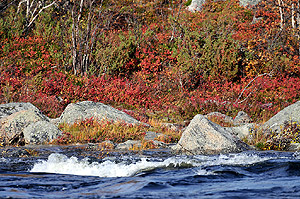
In Lapland small plants
on the ground retain beautiful colors much longer
than birch trees. |
Asian stations began to rise
around 1500 UTC. Conditions favored Thailand and
South Asia, without Aussie sightings. Iranians however
were very strong, and thanks to the new antenna,
we heard what seemed like nearly all existing Iranian
stations at 1630 UTC. Nothing interesting in the
evening, even the Brazilians were very weak.
Monday, September 17, 2012
Overnight conditions to the Western
hemisphere sporadically covered everything from
Atlantic Canada to Argentina, but no rarities were
immediately identified. U.S. stations were best
after 0300 UTC, and Latin Americans a bit later,
but even they vanished around 0400 UTC. Time to
get some sleep.
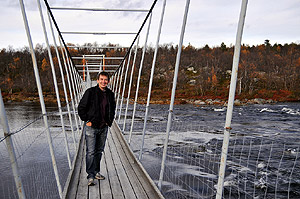
The narrow cable bridge
is a bit wobbly, but the only way to cross the
Näätämö River for miles
around. |
We continued antenna work,
installing grounding for both of the new wires. The
160-degree wire runs in fabulous terrain and has wonderful
views to the south from the end of the antenna. Back
at the cabin we rewarded ourselves by preparing some
nice Brazilian filet mignon with 2011 Chilean Tocornal
Cabernet Sauvignon.
Evening conditions began around
1500 UTC, but were worse than on the preceding days.
Some Central Asian stations were heard, then a bit
of South Asia and Middle East, and that's pretty
much it. Iranians were again pretty good at 1630
UTC. However, since we didn't have auroral conditions,
we didn't make any interesting catches from Africa
either. In the evening, this being the first weeknight,
it was time to check Spanish local breaks. SER breaks
were noted at 2058.00 and 2154.50 UTC, and COPE
at 2058.55 and 2154.55 UTC. No rarities, but for
instance COPE Alta Extremadura was noted on 900
kHz.
Tuesday, September 18, 2012
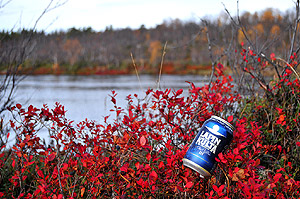
Lapin Kulta ("The Gold of Lapland")
is an indigenous species that produces bright
red leaves and canisters which contain a fairly
drinkable alcoholic beverage. Too bad that this
late into the season all the liquid that we
encountered during the hike had somehow evaporated. |
Brazilian stations emerged weak
on Monday evening around 2100 UTC, and continued
very poor through the night. U.S. stations first
surfaced briefly before 2330 UTC, only to disappear
right away, and gradually reappearing after 0130
until everything vanished before 0400 UTC.
In the morning our closest neighbor
was having a bit of an emergency situation, and
she came over to ask for our help. In the confusion
she drove off our driveway, and Jim's 4WD Honda
served as a good tow truck. All well in the end.

A neighbor got stuck on
our driveway. |
It was a rainy day, so we
took a break from outdoor labor. Evening conditions
to Asia began before 1500 UTC, but not much from East
Asia or even India. The most interesting time was
again at 1630 UTC, which is the best time to identify
Iranian stations. ABC's 1152 kHz transmitter in Western
Australia was finally heard late in the evening our
time, along with some Chinese and other Far East station,
but no other Aussies.
Wednesday, September 19, 2012
Indian stations were heard quite
well at sign-on time (around 0023 UTC). Practically
nothing was heard from Latin America overnight,
but U.S. stations emerged at midnight UTC and vanished
around 0400 UTC. Reception peaked around 0115 UTC,
but no new ones were identified. In the daytime
Jim went hiking to Saariselkä, while I checked
and fixed all our six antennas pointing to the Western
Hemisphere. A fallen tree had taken our 250-degree
wire to the ground, but fortunately the wire was
intact.

This particular shot of the northern lights
was not properly in focus, so a larger view
would reveal nothing more, but I picked this
one here because of a rare incident: a shooting
star in the same frame! |
Afternoon conditions to Asia
began around 1400 UTC with some Chinese stations
on the dial. Later on conditions
to Asia turned out to be miserable, once again.
Without the new 160-degree wire we would have had
nothing interesting to listen to. Looks like the
log will be full of IRIB stations. In the evening
impressive northern lights lit up the sky, and I
spent a couple of hours photographing them.
I only wish I had brought my tripod, but persistent
trial and error eventually produced some nice shots
of the Arctic sky.
Thursday, September 20, 2012
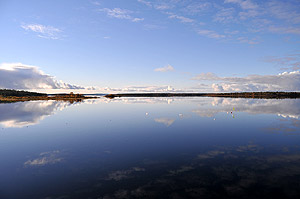
Porttipahta Reservoir
was totally calm. Notice the fyke in the foreground
- this is good whitefish territory. |
Overnight conditions were poor,
except for a few North American stations at daybreak,
including KPUR Amarillo TX on 1440 kHz. We slept
much of the rainy day. In the evening conditions
to Asia began exceptionally late, but we were fortunate
to hear more than just a couple of Aussies, catching
for instance 4CA on 846 kHz and 4RO on 990 kHz,
both from Queensland. The joy was over soon, but
in the evening the 160-degree wire offered some
African AM stations, such as Radio Veritas from
South Africa on 576 kHz. Having seven 1-kilometer-long
Beverage antennas to the Eastern Hemisphere gives
a nice selection in the evenings.
Friday, September 21, 2012
Overnight was rather poor to
all directions, but I was happy to get FEBA programming
on 1125 kHz, obviously via Sri Lanka. In the early
morning hours Manica from Mozambique gave a nice
signal on 1026 kHz, airing an interval signal and
repeated local station identifications at 0250-0300
UTC, so this is the best time to try to catch and
identify it. Practically no trans-Atlantic signals
were heard during the night or morning.
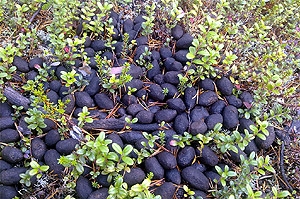
Shitty conditions, and this particular catch
remained unidentified. Is this where chocolate
comes from? |
We spent most of the daylight
hours checking and repairing our remaining antennas,
for instance rebuilding part of a broken 10-degree
antenna and fixing a coax feed line. Got a bit of
sunshine and several rain showers. Now the Aihkiniemi
antennas are all in prime condition.
Asian stations emerged around
1500 UTC, but conditions were poor. Once again catching
Iranian local stations at 1630 UTC was our evening
highlight, indicative of the quality of the conditions.
Saturday, September 22, 2012
During the night Brazilian and
Argentinean signals began to intensify after 0130
UTC and continued somewhat past 0400 UTC, which
should eventually give us a couple of new stations.
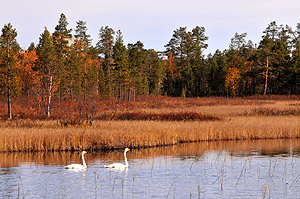
Many migratory birds use
our lake as a resting place on their way south. |
In the daytime we drove to Näätämö
on the Norwegian border and went hiking to the Näätämö
River, part of a large wilderness area. During the
4.5-hour hike we didn't see a single person on the
trail. The weather was favorable, and this was indeed
a very nice break from DXing and antenna work.
In the evening Asians began to invade the dial around
1500 UTC, but apart from some weak X-band signals,
we didn't hear Aussies. Cambodia on 918 kHz was
caught at closing time 1600 UTC. Once again we focused
on Iranians, a new one for today being Esfafan regional
programming on 1260 kHz (simulcasting with 837 AM
which is a regular). A bunch of East Asian powerhouses
continued late into the evening, so we kept a close
watch at Japanese NHK stations opening the broadcast
day. JOGK NHK1 Kumamoto via Minamata on 1341 kHz
was a major surprise, although the signal was weak.
Sunday, September 23, 2012

Lingonberries are favored
by DXers and bears, the two beasts at the top
of the food chain. |
Latin American stations were
heard during most of the morning hours, but signal
levels were not spectacular. As usual, stations
vanished by 0400 UTC.
Due to a cancellation nobody
would be DXing in the cottage for the upcoming two
weeks, so we gathered our remaining hard drives
and designed an ambitious automated recording schedule
until we would be returning ourselves in two weeks
for the AIH18 DXpedition. The arrangement allowed
us to leave all our stuff around the cabin without
the usual furious last-minute packing hassle, and
without hauling the hardware back and forth.
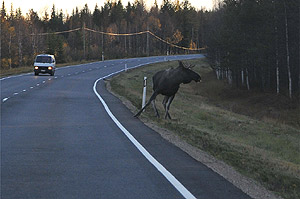
This moose fortunately
made a last-minute turn on the roadside and
headed back to the forest near Sodankylä
when we were returning south. |
September is the most dangerous
time of the year on the road when it comes to moose
encounters. When we were driving down from Sodankylä
on highway 4, we suddenly noticed a moose trying
to get across. Uncharacteristically the moose turned
around at the last minute. Usually they don't think
twice about crossing a road, whether there is traffic
or not. In any case Jim was alert, and we were far
enough and drove slow enough to avoid a collision.
We continued to Rovaniemi where we took the train
south, arriving in rainy Helsinki on Monday morning.
By this time you should be aching
to come over and try Aihkiniemi for yourself. The
good news is that we can make it happen. Aihkiniemi
is available for rent, and all the antennas are
just waiting for you. There are many vacant weeks
left during this winter. You can read more about
renting Aihkiniemi for your DXpedition of a lifetime
in this article.
Published
on September 29, 2012
  
|